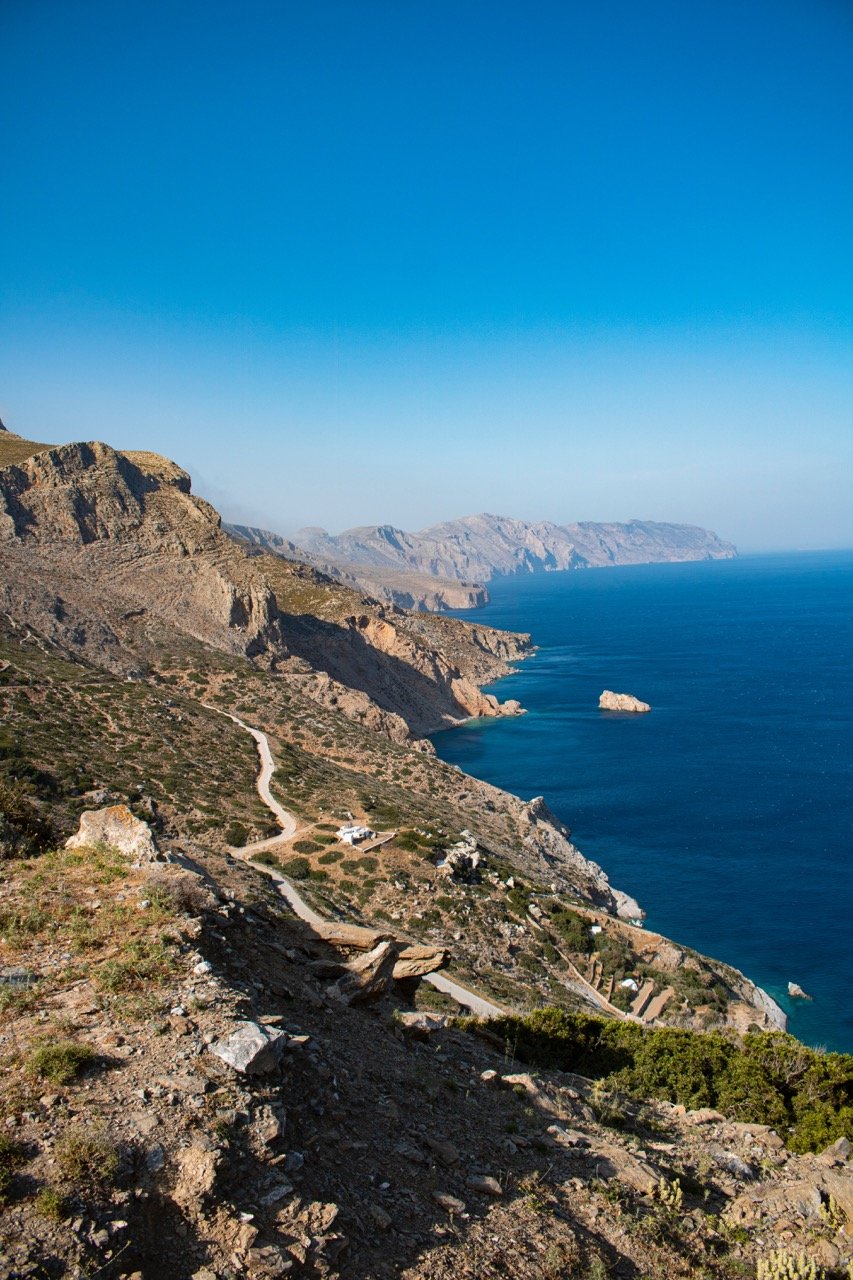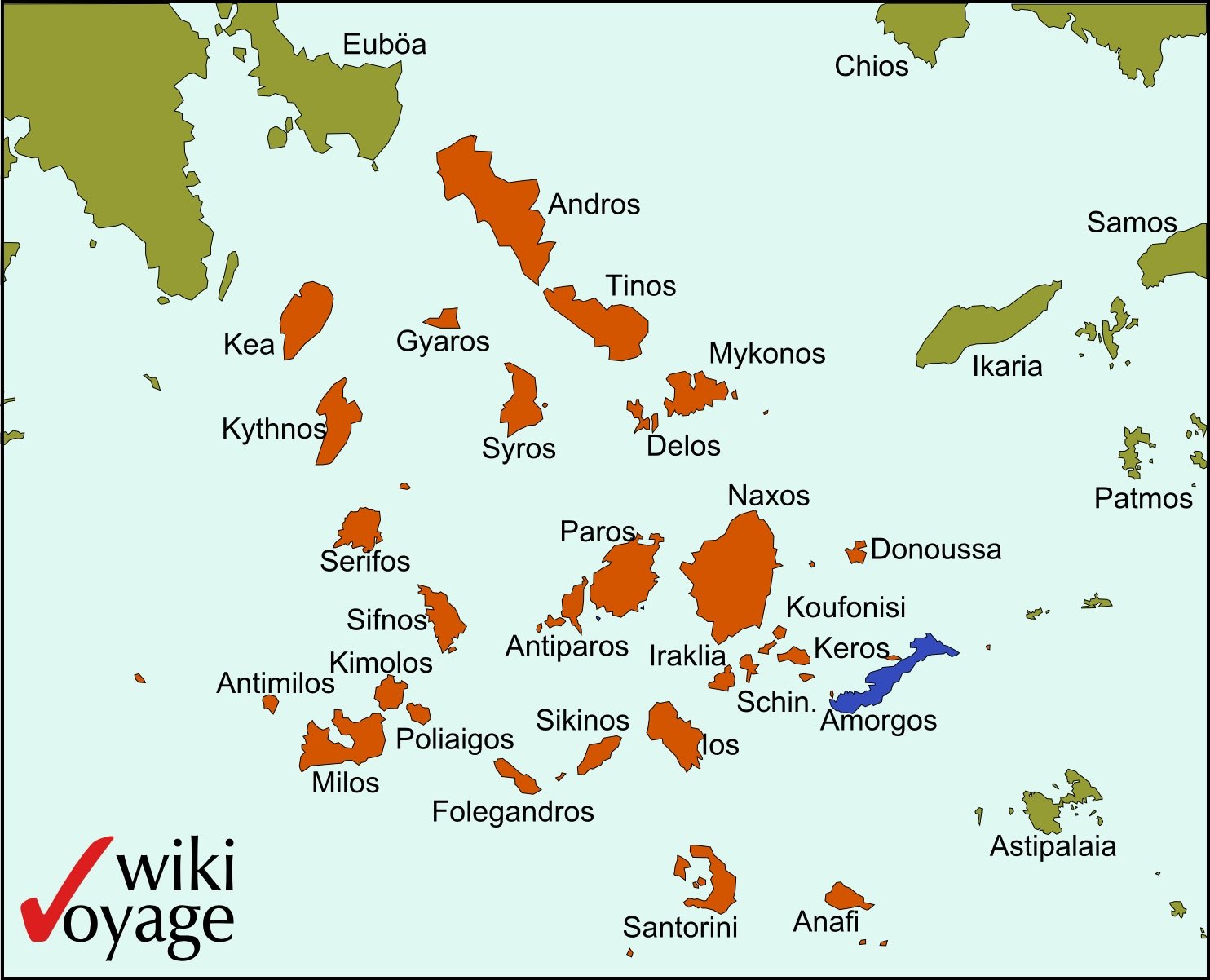A Local’s Guide to Visiting Amorgos, Greece
Affiliate disclosure: some of the links in this article are affiliate links. If you book using one of them, we’ll earn a small commission. All of our info is free to read and free of ads, so we appreciate it!
Long, narrow and wild, Amorgos was almost unknown until 1988, when French director Luc Bresson came to shoot the opening scenes of his free-diving classic The Big Blue, effectively putting the island on the map.
Amorgos has a spectacular coast, mountain scenery and a famous ‘hanging’ monastery wedged into sheer cliffs. It’s so rugged that the 25km road linking the two main ports in the north and south was only built in 1995.
With a year-round population hovering around 2,100, Amorgos is unspoiled, friendly and peaceful, and far from mass tourism and cruise ships. It’s a wonderful place to swim, snorkel and dive in crystal clear waters that really are exceptionally blue, or to walk along its ancient paths, and live, however briefly, in a very different world, far from the stresses of the 21st century.
Table of Contents


Where is Amorgos
Photo: User: Bgabel at wikivoyage shared, CC BY-SA 3.0, via Wikimedia Commons
Located 320 kilometers (172 nautical miles) south of Athens, Amorgos is the easternmost of the Cyclades, the closest Cycladic island to the Dodecanese islands, and midway between Crete and Ikaria.
To the west lie a scattering of small inhabited and uninhabited islands known as the Small Cyclades and the larger island of Naxos.
How to get there
Amorgos doesn’t have an airport, but it has two ports, Katapola and Aegiali, and ferries almost always call at both.
Arriving by ferry
From Piraeus, the port of Athens, ferries to Amorgos can take up to 9.5 hours depending on the schedule, often arriving at very unsocial hours. Prices start at $46 each way.
A quicker option is to catch a ferry from a nearby island, by first flying to Mykonos or Santorini from a European airport, or to the small domestic airport on Naxos if you’re coming from somewhere in Greece.
From Mykonos There are 3 fast Sea Jet ferries every week during the summer, that take around 2 hours and costs around $97 each way.
From Santorini Daily ferry connections to Amorgos take from 95 minutes up to 5½ hours depending on the route. Fast Sea Jet tickets are around $85 one way.
From Naxos Daily ferry connections to Amorgos take from 70 minutes up to 5½ hours; the fastest costing around $58. If you are island hopping, Amorgos’s own ferry boat, the Express Skopelitis links the island to Naxos and the four small Cyclades (Donousa, Koufonisi, Schinoussa, and Iraklia).
Where to buy ferry tickets
As a general rule, you pay more for speed: high-speed Sea Jet tickets cost at least 50% more than the slower ferries, and as with flights, the earlier you book your ticket, the cheaper the fares.
To check schedules and prices, I recommend using Ferry Scanner which is an aggregator that shows options from a bunch of different ferry companies. Their schedules are always up to date, it’s easy to use, and the price difference between using them and booking direct is negligible.
Why visit
Away from the mainstream, dramatically rugged Amorgos is for anyone seeking an unspoiled island with traditional whitewashed villages and absolutely crystal clear seas, perfect for swimming or diving.
Beyond its spectacular must-see monastery, it’s a great laid-back island for relaxing, breathing in the pure air, taking long walks, joining in traditional festivals (paniyiria), and marvelling at star-filled nights.
What is Amorgos known for
These days Amorgos is best known as the setting of several scenes in The Big Blue, and by extension, for scuba and free diving in its transparent seas that are far from any pollution.
There are sandy and pebble beaches scattered on all coasts, including remote ones (mostly in the south). It’s a delightfully authentic and friendly island, with whitewashed Cycladic villages set admist breathtaking mountain scenery.
The capital, Chora (or Amorgos Town), is near the center of the island, piled on a hill under a giant rock crowned by a ruined Venetian castle. With its windmills and 44 churches (one of which can barely fit in two people and is considered the smallest in Greece!), the town is certainly one of the most beautiful villages in the Cyclades.
You can walk from here to the famous 11th-century monastery of Panagia Chozoviotissa which is spectacularly embedded in a cliff, and is also near a few small but beautiful beaches.
Katapola, the port of Chora and southern Amorgos, has a decent beach and a good selection of hotels and restaurants. The section of the island south of Katapola supports small farming villages and has some of the island’s best beaches, most of which are more or less accessible by road.
Wherever you go, you’ll see excellent examples of the dry stone walls that the Greeks excel at and are listed by UNESCO as part of the Intangible Cultural Heritage of Humanity.
The pretty port of Aegiali in the north has the longest sandy beach on Amorgos and is also the chic place to stay, with its contemporary hotels, both in town and in the beautiful traditional villages on the hills above—Potamos, Lagada and Tholaria, which offer excellent trekking.
Outside of its remarkable vertiginous monastery, Amorgos doesn’t have any must-see sights, but it does have a positive, feel-good energy that has made it a destination for yoga and wellness retreats. It’s an ideal place for couples or families in search of an authentic, traditional Greek island.
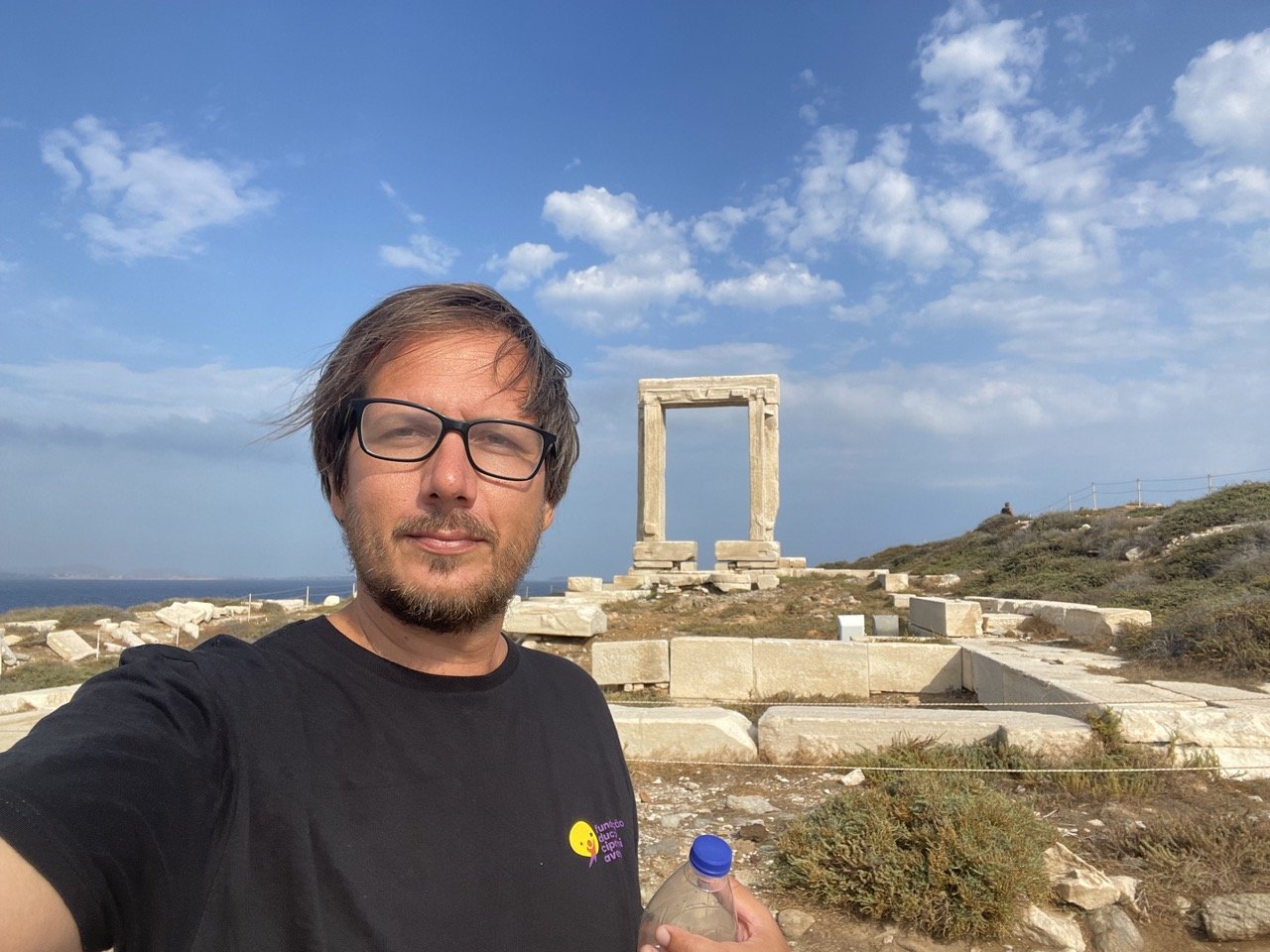

How long to spend
The lure of Amorgos is its remoteness, its crystal clear sea, and peace and quiet. To enjoy this and get a feel for the island’s wild beauty, plan to stay a minimum of 3 days.
Spend one day visiting Chora, the Chozoviotissa monastery and nearby beaches, another in a car or bike touring the southern beaches and the shipwreck, and a third day exploring Aegiali and the pretty villages of Lagada, Tholaria, and Potamos.
That said, Amorgos really is more of an island for lingering rather than a quick hop around, and it’s very pleasant to spend extended periods here. You could consider combining it with Santorini for a study in contrast, one cosmopolitan and spectacular, the other (Amorgos) low key, relaxing, very Greek, and spectacular in a different way.
What to see & do
1. Visit the Monastery of Panagia Chozoviotissa
Greece is a country of spectacular Byzantine monasteries, and Panagia Chozoviotissa is one of the very best and oldest, dating from the 11th century and embedded in a sheer cliff just east of Chora—allegedly the exact spot chosen by the Virgin when a band of monks transported a miraculous icon into the Aegean from the Holy Land.
Eight storeys high, it once sheltered 100 monks. Today there are three who welcome visitors to the chapel of the famous icon, and serve them psimeni raki (Amorgos’s famous ‘roasted raki’, with honey and cloves) and loukoumi (aka Turkish delight).
2. Dive into the Big Blue
With its limpid waters full of marine life and sponges, caves and islets, ancient and recent shipwrecks (including the Marina 3 cargo vessel that sank in 1981) diving is extremely popular on Amorgos.
There are two scuba and free diving schools on the island: the We Shall Sea Dive Center in Katapola and the Amorgos Diving Center in Aegiali.
3. Wander through the ruins of ancient Minoa
In ancient times, Amorgos supported three cities—one of which yielded the largest prehistoric Cycladic idol ever found, standing nearly 5ft tall and now in the National Archaeology Museum in Athens.
A short walk up the hill from Katapola you can visit the ancient Minoa, founded in 11th-century BC and inhabited until the 4th century AD, which has the most extant ruins and some of the most impressive dry stone walls.
4. Try local food specialties on a gastro tour
Take a guided food oriented tour of the traditional village of Langada near Aegiali, meeting local producers and cooks, and tasting the island’s specialities, including olive oil (the tour includes a visit to an olive press) cheeses, sweets and psimeni raki.
5. Take a hike
There are seven ‘Blue Trails’ on Amorgos that take anywhere from an easy hour stroll to a full day trek over the mountains. Because the island is so narrow, no matter where you go you are rarely out of sight of the sea—hence ‘Blue.’
6. Visit the island's shipwreck
Although the iconic Shipwreck Beach on Zakynthos is now mostly off limits because of its crumbling cliffs, you can visit Amorgos’s own little shipwreck beach near the southern tip of the island. The Olympus went aground in fierce winds in 1980, and made an appearance in The Big Blue.
7. Try herb-infused cocktails
Amorgos Botanical Park in Katapola is an outdoor garden bar, where a group of young locals cultivate the island’s herbs and serve delicious drinks, often with live music or a film.
8. Watch the sun set at Agia Triada chapel
One of the best places to see the sun set in the north of Amorgos is from the chapel of Agia Triada, embedded high in a cliff—a spot where the locals once hid from pirates. It’s up a narrow path from Lagada, and has views that take in all of Aegiali Bay.
Best beaches
Aegiali
This sandy beach is so long it’s hardly ever crowded. Because the sea is shallow and there’s a playground, tavernas and cafes only a short walk away, it’s one of the most popular with families with small children.
Agios Pavlos
This pebble and sand beach 5km southwest of Aegiali is calm and sheltered, and close to the uninhabited islet of Nikouria. In summer, hourly boats from Agios Pavlos make the 10 minute crossing to Nikouria’s beautiful sandy beaches, but you’ll need to bring along everything you need.
Levrosses
This sandy beach with turquoise waters and a beach bar is surrounded by cliffs, but easily accessible via a path from Tholaria or by taxi boat from Aegiali; you can also park above and walk down.
Agia Anna
Under a picture perfect white chapel, this narrow rocky/pebble beach with its deep blue waters was used in The Big Blue. It’s an ideal for diving and snorkelling, but not recommended for young children. You can drive there or walk in about 20 minutes from the Chozoviotissa Monastery.
Mouros
A little unorganized beach with a single taverna, Mouros is known for the beautiful color of the water, its rock formations, and two little caves you can explore with a snorkel. It’s located near the village of Kamari in the island’s south; you can park within a 10-minute walk.
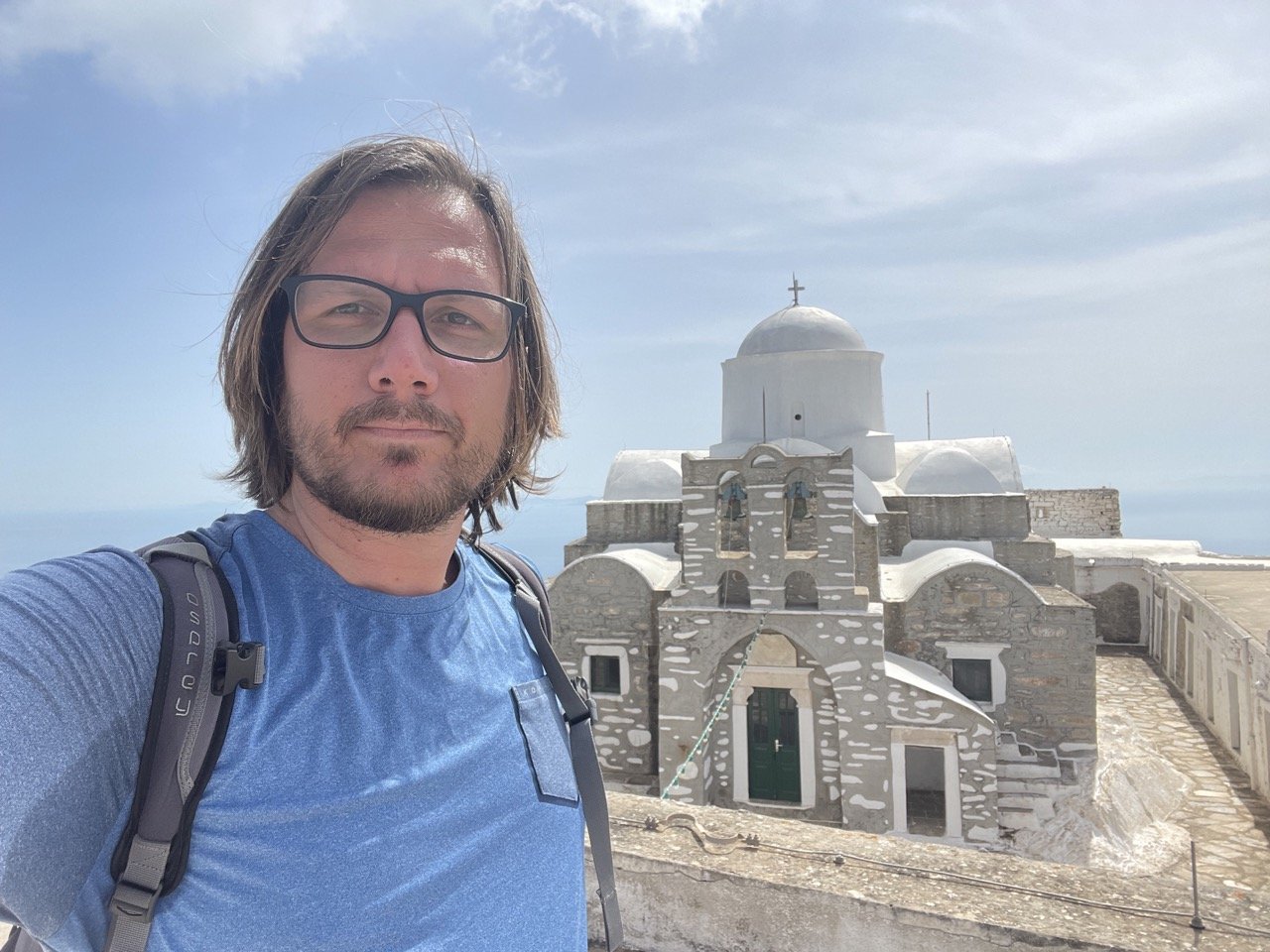

Where to stay
Most hotels and guesthouses on the island are small and family run, and it’s absolutely essential to book early for the summer.
Aegiali
Boutique hotels with all creature comforts are concentrated in Aegiali with its excellent beach, great restaurants, and little shops, and nearby pretty walks through some of the Amorgos’s greener villages.
Aegialis Hotel & Spa is the only five star hotel on the island. It has stunning views, a pool, and a spa; it often hosts yoga retreats ($300 a night in summer).
Just outside Aegiali in the town of Potamos, Hotel Pano Gitona is quiet and relaxing, in traditional island style and built on a hill so each room sports a veranda with gorgeous views. Rooms cost from 60-100 euros depending on the month, and you can only book directly through the property.
Aegiali Camping has plenty of shade—but you will need to bring your own tent or sleeping bag.
Chora
Up in the lovely capital Chora away from the beaches, the atmosphere is charming and timeless, offering an authentic village experience. Choices here are between small guest houses (‘rent rooms’) and a boutique hotel.
In Chora, besides the small guest houses, there’s Vorina Ktismata, with seven apartments in Cycladic minimalist style, luxuriously finished with made-in-Greece Cocomat linens and the latest mod-cons; each comes with a veranda/garden with fabulous views over mountains and the sea. Rooms and villas from from $200 to $400 per night over the summer.
Katapola
The southern port of Katapola has a beach as well and numerous reasonably priced little hotels; it’s convenient for visiting Chora and the beaches in the south.
The recently built Amorgos Pearls apartments in a garden overlooking the bay are amongst the nicest places to stay in Katapola.
Saint George Valsamitis has a large selection of rooms and a good bar/restaurant ($70 per night).
Five minutes from the beach, Porto Katapola has friendly owners and cheap and cheerful rooms and apartments, some perfect for families ($65 per night). The municipal campground is here as well, with tents you can rent.
Agios Pavlos
If you have a car, Agios Pavlos on the eponymous beach is a good option, where you can see a billion stars at night, yet are only a ten minute drive from Aegiali.
If you’d like to be more isolated, Aspes Village offers 11 well-furnished apartments sleeping from two to six, located in a very peaceful spot 50 yards from the beach, with a convenient taverna next door ($100 per night).
How to get around
Because it’s so mountainous, Amorgos can seem larger that its 48.7 square miles. If you are sticking to the main centres for two or three days, you can probably get by with the local buses and taxis.
Public transportation
The Amorgos Bus Company has at least two services a day between Katapola and Aegiali (traversing the island from north to south), and 3 a day between Katapola, Chora and the monastery. There are also twice daily connections between Aegiali and Tholaria and Lagada. Tickets range from $2—$2.50.
Renting a car
But to really get the most out of the island, your own transportation comes in handy, even if you just hire one for a day. Because numbers are limited, book before you arrive. Try Amorgos Rent Car, who will deliver cars to anywhere on the island, or Amorgos Blue in Katapola.
You also can rent a car or motorbike with FM Rent a car Amorgos located in Katapola and Aegiali.
I also always recommend checking prices on DiscoverCars, a car rental aggregator site that includes offerings from all the major international rental companies as well as lots of smaller local agencies, which often have much better pricing. You can often find great deals.
E-bike
If you want to be a bit more active, you can hire an e-bike or take a guided tour with E-Bike Amorgos.
Taxis
For a taxi in Katapola, ring +30 6932 000 455 or +30 6932 103 077; in Aegiali +30 6937 883 838; and in Chora +30 6973 988 702.
Weather
Spring
Amorgos is at its greenest, and by April it’s very pleasant to take long hikes. In April, the Amorgos Trail Challenge takes place, with four running events including the 19km Palia Strata race, along the ancient road. Greek Easter in April or May is a great time to visit, when the village lanes are spread with wild herbs, little bonfires are lit in Chora and Katapola, followed by fireworks, feasting and a procession of icons.
Summer
This is when everything is open, temperatures are hottest, winds the windiest, and ferries the most frequent. On 26 July the island holds one of biggest paniyri (traditional festival) in the Cyclades in honour of Agia Paraskevi, followed the next day the Psimeni Raki festival in Katapola. Mid-August sees celebrations for the Assumption of the Virgin and a Pasteli Festival (sesame and honey bars) in Chora.
Fall
After August there is a more relaxed feel and cooler temperatures; the sea stays warm enough for a dip into October. In mid-September the island hosts the Authentic Big Blue Freediving Championships; in November the five-day Amorgos Film Festival takes place, dedicated to international documentaries about tourism.


More Greece travel info
For more advice on planning your trip to Greece, have a look at some of our other guides and itineraries!
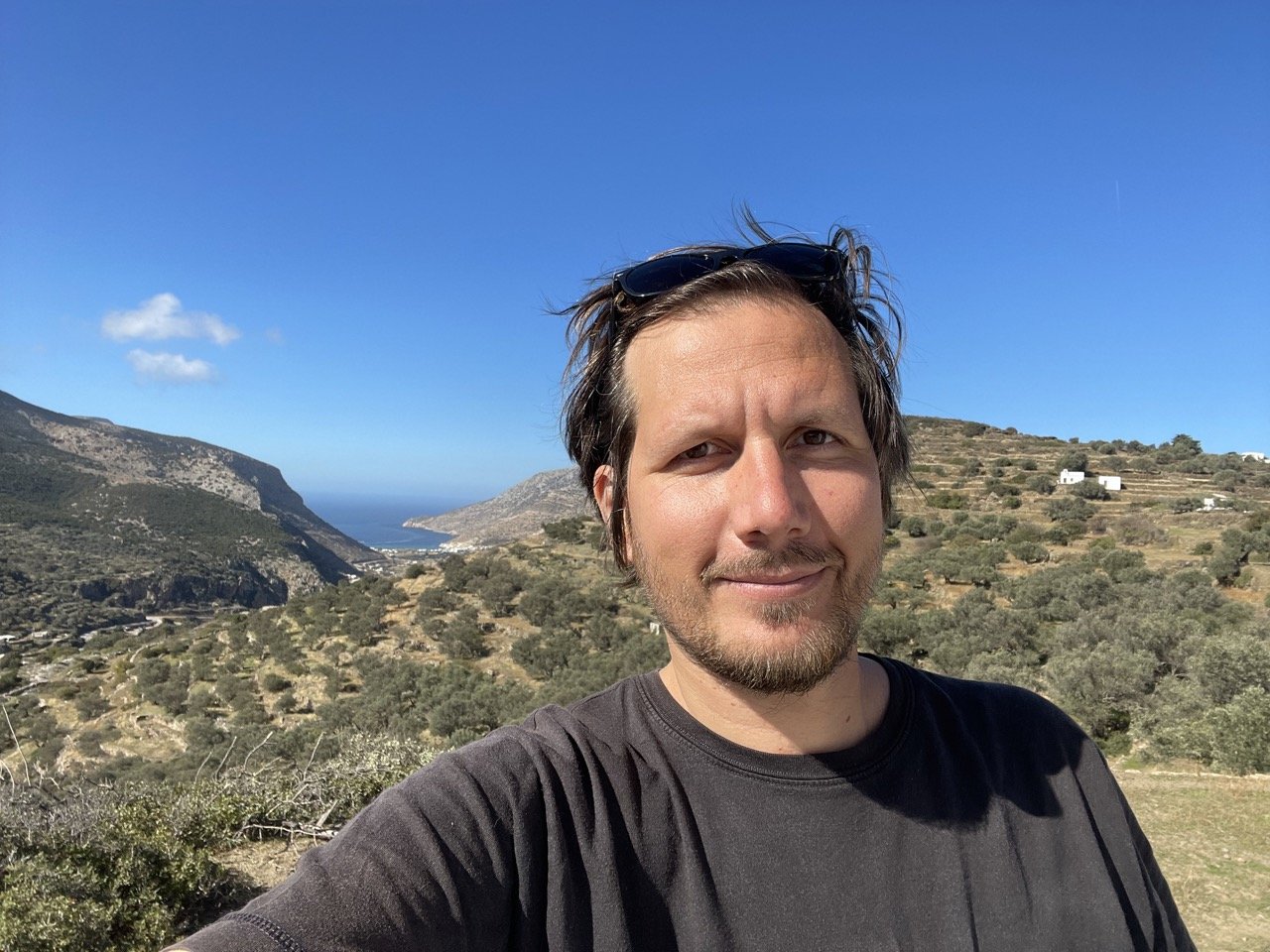
Connect with Luca
